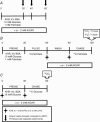AMP kinase activation with AICAR simultaneously increases fatty acid and glucose oxidation in resting rat soleus muscle
- PMID: 15774530
- PMCID: PMC1464538
- DOI: 10.1113/jphysiol.2004.081679
AMP kinase activation with AICAR simultaneously increases fatty acid and glucose oxidation in resting rat soleus muscle
Abstract
5-Amino-4-imidazolecarboxamide riboside (AICAR), a pharmacological activator of AMP-activated protein kinase (AMPK), acutely stimulates glucose uptake and fatty acid (FA) oxidation in skeletal muscle. However, it is not fully understood whether AICAR-induced changes in glucose oxidation are secondary to changes in FA oxidation (i.e. glucose fatty acid cycle), or what role AMPK may be playing in the regulation of intramuscular triacylglycerol (TAG) esterification and hydrolysis. We examined the acute (60 min) effects of AICAR (2 mm) on FA metabolism, glucose oxidation and pyruvate dehydrogenase (PDH) activation in isolated resting rat soleus muscle strips exposed to two different FA concentrations (low fatty acid, LFA, 0.2 mm; high fatty acid, HFA, 1 mm). AICAR significantly increased AMPK alpha2 activity (+192%; P<0.05) over 60 min, and simultaneously increased both FA (LFA: +33%, P<0.05; HFA: +36%, P<0.05) and glucose (LFA: +105%, P<0.05; HFA: +170, P<0.001) oxidation regardless of FA availability. While there were no changes in TAG esterification, AICAR did increase the ratio of FA partitioned to oxidation relative to TAG esterification (LFA: +15%, P<0.05; HFA: +49%, P<0.05). AICAR had no effect on endogenous TAG hydrolysis and oxidation in resting soleus. The stimulation of glucose oxidation with AICAR was associated with an increase in PDH activation (+126%; P<0.05) but was without effect on pyruvate, an allosteric activator of the PDH complex, suggesting that AMPK may stimulate PDH directly. In conclusion, AMPK appears to be an important regulator of both FA metabolism and glucose oxidation in resting skeletal muscle.
Figures





Similar articles
-
AMP kinase activation with AICAR further increases fatty acid oxidation and blunts triacylglycerol hydrolysis in contracting rat soleus muscle.J Physiol. 2005 Jun 1;565(Pt 2):547-53. doi: 10.1113/jphysiol.2004.081687. Epub 2005 Mar 17. J Physiol. 2005. PMID: 15774529 Free PMC article.
-
AMPK activation is not critical in the regulation of muscle FA uptake and oxidation during low-intensity muscle contraction.Am J Physiol Endocrinol Metab. 2005 Mar;288(3):E592-8. doi: 10.1152/ajpendo.00301.2004. Epub 2004 Nov 16. Am J Physiol Endocrinol Metab. 2005. PMID: 15547141
-
Short-term AMP-regulated protein kinase activation enhances insulin-sensitive fatty acid uptake and increases the effects of insulin on fatty acid oxidation in L6 muscle cells.Exp Biol Med (Maywood). 2010 Apr;235(4):514-21. doi: 10.1258/ebm.2009.009228. Exp Biol Med (Maywood). 2010. PMID: 20407084
-
AMP-activated protein kinase and muscle glucose uptake.Acta Physiol Scand. 2003 Aug;178(4):337-45. doi: 10.1046/j.1365-201X.2003.01168.x. Acta Physiol Scand. 2003. PMID: 12864738 Review.
-
Exercise-induced AMPK activity in skeletal muscle: role in glucose uptake and insulin sensitivity.Mol Cell Endocrinol. 2013 Feb 25;366(2):204-14. doi: 10.1016/j.mce.2012.06.013. Epub 2012 Jul 11. Mol Cell Endocrinol. 2013. PMID: 22796442 Review.
Cited by
-
Nitric oxide and AMPK cooperatively regulate PGC-1 in skeletal muscle cells.J Physiol. 2010 Sep 15;588(Pt 18):3551-66. doi: 10.1113/jphysiol.2010.194035. Epub 2010 Jul 19. J Physiol. 2010. PMID: 20643772 Free PMC article.
-
Dietary Cocoa Flavanols Enhance Mitochondrial Function in Skeletal Muscle and Modify Whole-Body Metabolism in Healthy Mice.Nutrients. 2021 Sep 29;13(10):3466. doi: 10.3390/nu13103466. Nutrients. 2021. PMID: 34684467 Free PMC article.
-
Iron promotes glycolysis to drive colon tumorigenesis.Biochim Biophys Acta Mol Basis Dis. 2023 Dec;1869(8):166846. doi: 10.1016/j.bbadis.2023.166846. Epub 2023 Aug 12. Biochim Biophys Acta Mol Basis Dis. 2023. PMID: 37579983 Free PMC article.
-
Yhhu981, a novel compound, stimulates fatty acid oxidation via the activation of AMPK and ameliorates lipid metabolism disorder in ob/ob mice.Acta Pharmacol Sin. 2015 Mar;36(3):343-52. doi: 10.1038/aps.2014.147. Acta Pharmacol Sin. 2015. PMID: 25732571 Free PMC article.
-
AMP kinase activation with AICAR further increases fatty acid oxidation and blunts triacylglycerol hydrolysis in contracting rat soleus muscle.J Physiol. 2005 Jun 1;565(Pt 2):547-53. doi: 10.1113/jphysiol.2004.081687. Epub 2005 Mar 17. J Physiol. 2005. PMID: 15774529 Free PMC article.
References
-
- Ai H, Ihlemann J, Hellsten Y, Lauritzen HP, Hardie DG, Galbo H, Ploug T. Effect of fiber type and nutritional state on AICAR- and contraction-stimulated glucose transport in rat muscle. Am J Physiol Endocrinol Metab. 2002;282:E1291–E1300. - PubMed
-
- Aschenbach WG, Hirshman MF, Fujii N, Sakamoto K, Howlett KF, Goodyear LJ. Effect of AICAR treatment on glycogen metabolism in skeletal muscle. Diabetes. 2002;51:567–573. - PubMed
-
- Bergeron R, Russell RR, III, Young LH, Ren J-M, Marcucci M, Lee A, Shulman GI. Effect of AMPK activation on muscle glucose metabolism in conscious rats. Am J Physiol Endocrinol Metab. 1999;276:E938–E944. - PubMed
-
- Chen Z-P, McConnell GK, Michell BJ, Snow RJ, Canny BJ, Kemp BE. AMPK signaling in contracting human skeletal muscle: acetyl-CoA carboxylase and NO synthase phosphorylation. Am J Physiol Endocrinol Metab. 2000;279:E1202–E1206. - PubMed
Publication types
MeSH terms
Substances
LinkOut - more resources
Full Text Sources
Medical

